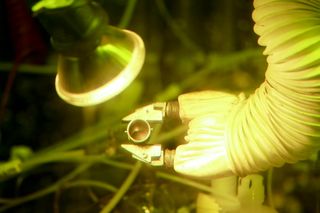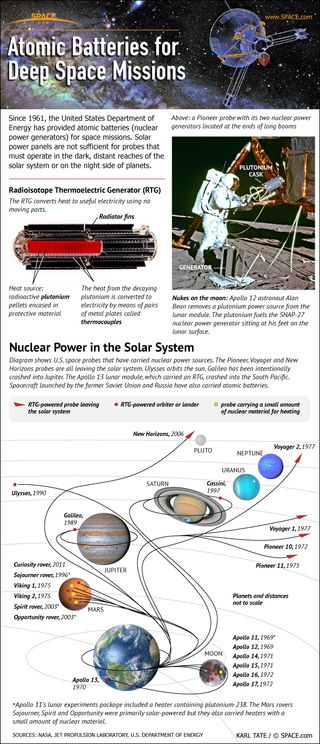Production of Plutonium Spacecraft Fuel Could Boom in Early 2020s

The production of nuclear spacecraft fuel, currently a dwindling resource, could go into overdrive in the early 2020s.
A public-private partnership led by a company called Technical Solutions Management (TSM) aims to start generating usable amounts of plutonium-238 (Pu-238) — the material that powers deep-space explorers such as NASA's Curiosity Mars rover and New Horizons Pluto probe — by 2022 or so.
This newly unveiled project would complement, not supplant, the Pu-238 production efforts currently underway at the U.S. Department of Energy (DOE), said TSM CEO Billy Shipp. [US Makes Plutonium-238 for Deep-Space Exploration (Video)]
TSM's work "could establish a redundancy in the production of plutonium; it could potentially increase capacity, if the [NASA] missions needed increased capacity, and as a result, it could minimize the programmatic risk overall to the space program," Shipp, a former director of the DOE's Idaho National Engineering and Environmental Laboratory (now known as the Idaho National Laboratory, or INL), told Space.com.
Nuclear-powered exploration
Pu-238 is the key ingredient in radioisotope thermoelectric generators (RTGs), which convert, into electricity, the heat produced by the radioactive stuff when it naturally decays into uranium-234.
Most of NASA's iconic planetary-exploration missions over the decades have depended on RTGs, including the twin Voyager 1 and Voyager 2 probes, the Viking 1 and Viking 2 Mars landers, and the Cassini Saturn orbiter.
The United States used to produce the Pu-238 needed for such spacecraft at the DOE's Savannah River Site in South Carolina, as an offshoot of the facility's weapons work. (Pu-238 is not a bomb-making material, but its close cousin Pu-239 is.)
Get the Space.com Newsletter
Breaking space news, the latest updates on rocket launches, skywatching events and more!
That production line ceased in 1988, as the Cold War wound down. The U.S. began buying Pu-238 from Russia in 1992 but received its last shipment from Moscow in 2010. Since then, the U.S. stockpile has been shrinking; NASA's allocation is now down to about 77 lbs. (35 kilograms), only half of which is usable in its current state, agency officials have said (though the rest could conceivably be brought up to grade by blending it with newly produced Pu-238).
NASA's current RTG design, known as the Multi-Mission Radioisotope Thermoelectric Generator, requires 10.6 lbs. (4.8 kg) of Pu-238. So, currently, the U.S. has enough Pu-238 to power just three or four more deep-space missions. [Nuclear Generators Power NASA Deep-Space Probes (Infographic)]
Pu-238 restart — times two?
But efforts to avoid a nuclear-fuel shortage are underway.
The DOE recently started a new Pu-238 production program, which manufactured a 1.8-ounce (50 grams) sample of the stuff at the Oak Ridge National Laboratory (ORNL) in Tennessee in late 2015. If everything goes according to plan, this pipeline should begin churning out the amount that NASA has requested — 3.3 lbs. (1.5 kg) of Pu-238 every year — by 2023, DOE officials have said.
TSM's production would supplement that of the DOE , Shipp said.
The company publicly unveiled its plans a few weeks ago, at the Nuclear and Emerging Technologies for Space 2017 conference in Orlando, Florida, but the project has been in the works for several years.
"We have done this project very quietly, because we simply didn't want to have any kind of public pronouncements until we had a confidence level that organizations of this caliber could stand behind," Shipp said.

The organizations he referred to are the key partners in the new Pu-238 production effort: Canadian Nuclear Laboratories (CNL), the DOE's Pacific Northwest National Laboratory (PNNL), and Ontario Power Generation (OPG), a corporation owned by the Ontario government.
Here's how it will work. PNNL has developed new technology for producing "targets" made of neptunium-237, Shipp said. These targets will be shipped to CNL's Chalk River Laboratories in Ontario, where they will be assembled into reactor bundles. These bundles will then go to OPG's Darlington reactor, where they will be irradiated to generate plutonium-238. Then, the bundles will head back to CNL for disassembly and chemical processing. (The DOE's plutonium pipeline is similarly complex, involving ORNL, INL and Los Alamos National Laboratory in New Mexico.)
OPG reactors already generate cobalt-60, which is used to sterilize surgical and medical equipment. So commercial isotope production is not a foreign concept, Shipp said.
"There are no known showstoppers in this, so we're highly confident from both a regulatory base as well as a technical base that this will go forward," he said.
Indeed, the ball is rolling on the project, which is managed by TSM. (TSM also licensed the PNNL technology.) Two neptunium-237 targets have been built, and they were put into a CNL reactor for qualification purposes this month, Shipp said. One target will stay in for 90 days, and the other will remain for 300 days, he added.
The next phase of the project — which the team aims to start toward the end of this year, if it can raise enough funding — involves qualification of the reactor bundles. Then, the project will develop and demonstrate an overall "flow sheet" of Pu-238 production from start to finish, Shipp said.
If everything goes according to plan, the TSM-led effort could be in production as early as 2022. The process is designed to make 11 lbs. (5 kg) of Pu-238 per year, though yields could nearly double if the customer desired, Shipp said.
That customer would likely be the DOE (and, by extension, NASA), he said, primarily because the neptunium-237 needed to make the targets comes from the U.S. federal government. Shipp also anticipates collaborating with the DOE to some degree on an overall manufacturing strategy.
"Our desire is to have a fully integrated plutonium-238 mission for DOE that we're just a part of," he said.
In addition to making the Pu-238 production system more robust, the TSM-led effort could help the nation rebuild its nuclear-fuel stockpile, potentially enabling increased planetary exploration down the road, Shipp added.
"Our space program is a dynamic program," Shipp said. "We stand really ready to assist the program in how it may evolve." [NASA's 10 Greatest Science Missions]
Talking to NASA
Shipp said his team has discussed its plans with NASA informally. Official discussions should begin soon, he added; the group plans to submit a funding proposal to the DOE and NASA to help pay for Phase 2 of its project (qualification of the bundles).
Assuming the current DOE manufacturing effort proceeds as planned, NASA won't face a Pu-238 shortage anytime soon, said David Schurr, deputy director of the space agency's Planetary Science division.
"That's clearly enough through 2030," Schurr told Space.com. (He declined to forecast any further into the future, saying not enough is known yet about NASA's post-2030 plans.)
Schurr voiced theoretical support for adding another player to the Pu-238 pipeline: "Having other reactor sources is a good thing," he said. But he stressed that the DOE, not NASA, is in charge of plutonium production and will therefore have chief responsibility for assessing any proposal by the TSM group.
"At the end of the day, I'm looking for inexpensive ways to get my job done," Schurr said. "So if DOE says they like it, then I'm interested."
Follow Mike Wall on Twitter @michaeldwall and Google+. Follow us @Spacedotcom, Facebook or Google+. Originally published on Space.com.
Join our Space Forums to keep talking space on the latest missions, night sky and more! And if you have a news tip, correction or comment, let us know at: community@space.com.

Michael Wall is a Senior Space Writer with Space.com and joined the team in 2010. He primarily covers exoplanets, spaceflight and military space, but has been known to dabble in the space art beat. His book about the search for alien life, "Out There," was published on Nov. 13, 2018. Before becoming a science writer, Michael worked as a herpetologist and wildlife biologist. He has a Ph.D. in evolutionary biology from the University of Sydney, Australia, a bachelor's degree from the University of Arizona, and a graduate certificate in science writing from the University of California, Santa Cruz. To find out what his latest project is, you can follow Michael on Twitter.
